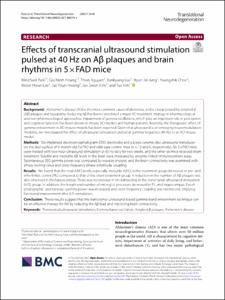Department of Electrical Engineering and Computer Science
MBIS(Multimodal Biomedical Imaging and System) Laboratory
1. Journal Articles
Effects of transcranial ultrasound stimulation pulsed at 40 Hz on A beta plaques and brain rhythms in 5xFAD mice
- Title
- Effects of transcranial ultrasound stimulation pulsed at 40 Hz on A beta plaques and brain rhythms in 5xFAD mice
- Author(s)
- Park, Mincheol ; Hoang, Gia Minh ; Nguyen, Thien ; Lee, Eunkyung ; Jung, Hyun Jin ; Choe, Youngshik ; Lee, Moon Hwan ; Hwang, Jae Youn ; Kim, Jae Gwan ; Kim, Tae
- Issued Date
- 2021-12
- Citation
- Translational Neurodegeneration, v.10, no.1
- Type
- Article
- Author Keywords
- Transcranial ultrasound stimulation ; Gamma band oscillation ; Amyloid-beta plaques ; Alzheimer&apos ; s disease
- Keywords
- ALZHEIMERS-DISEASE ; GAMMA OSCILLATIONS ; FOCUSED ULTRASOUND ; EEG SYNCHRONIZATION ; MOUSE MODELS ; NEURODEGENERATION ; INTERNEURONS ; IMPAIRMENT ; MICROGLIA ; TOXICITY
- ISSN
- 2047-9158
- Abstract
- Background: Alzheimer’s disease (AD) is the most common cause of dementia, and is characterized by amyloid-β (Aβ) plaques and tauopathy. Reducing Aβ has been considered a major AD treatment strategy in pharmacological and non-pharmacological approaches. Impairment of gamma oscillations, which play an important role in perception and cognitive function, has been shown in mouse AD models and human patients. Recently, the therapeutic effect of gamma entrainment in AD mouse models has been reported. Given that ultrasound is an emerging neuromodulation modality, we investigated the effect of ultrasound stimulation pulsed at gamma frequency (40 Hz) in an AD mouse model. Methods: We implanted electroencephalogram (EEG) electrodes and a piezo-ceramic disc ultrasound transducer on the skull surface of 6-month-old 5×FAD and wild-type control mice (n = 12 and 6, respectively). Six 5×FAD mice were treated with two-hour ultrasound stimulation at 40 Hz daily for two weeks, and the other six mice received sham treatment. Soluble and insoluble Aβ levels in the brain were measured by enzyme-linked immunosorbent assay. Spontaneous EEG gamma power was computed by wavelet analysis, and the brain connectivity was examined with phase-locking value and cross-frequency phase-amplitude coupling. Results: We found that the total Aβ42 levels, especially insoluble Aβ42, in the treatment group decreased in pre- and infra-limbic cortex (PIL) compared to that of the sham treatment group. A reduction in the number of Aβ plaques was also observed in the hippocampus. There was no increase in microbleeding in the transcranial ultrasound stimulation (tUS) group. In addition, the length and number of microglial processes decreased in PIL and hippocampus. Encelphalographic spontaneous gamma power was increased, and cross-frequency coupling was normalized, implying functional improvement after tUS stimulation. Conclusion: These results suggest that the transcranial ultrasound-based gamma-band entrainment technique can be an effective therapy for AD by reducing the Aβ load and improving brain connectivity. © 2021, The Author(s).
- Publisher
- BioMed Central
- Related Researcher
-
-
Hwang, Jae Youn
- Research Interests Multimodal Imaging; High-Frequency Ultrasound Microbeam; Ultrasound Imaging and Analysis; 스마트 헬스케어; Biomedical optical system
-
- Files in This Item:
-
 기타 데이터 / 3.12 MB / Adobe PDF
download
기타 데이터 / 3.12 MB / Adobe PDF
download



